2-8-4 "Berkshire" Locomotives: Development, Photos, Survivors
Last revised: March 1, 2025
By: Adam Burns
The 2-8-4 Berkshire , a triumph of engineering elegance and functionality, stands out as one of the most stunning steam locomotives designed for medium to heavy-duty tasks. Renowned not only for their visual appeal, these engines also demonstrated remarkable prowess in hauling substantial freight loads.
The Berkshire class, embraced by numerous railroads for its efficiency and performance, is particularly remembered for its seminal deployment on the Boston & Albany Railroad.
It was during rigorous testing in the scenic Berkshire Mountains of New England that this locomotive class acquired its name. Impressed by their performance, the Boston & Albany would go on to acquire a substantial fleet of these formidable 2-8-4s, securing their place in the annals of railway history.
As pioneers of the "Super Power" designs, the 2-8-4s enjoyed widespread acclaim and versatility across various railroads. Employed primarily in standard freight service, they showcased their adaptability by performing a plethora of tasks, from hauling coal to transporting merchandise.
Currently, several specimens of these historic locomotives have been preserved, with two of them still operational. This makes them among the largest and most impressive designs that the public can still experience in action today, offering a tangible link to the rich heritage of rail transportation.
Photos
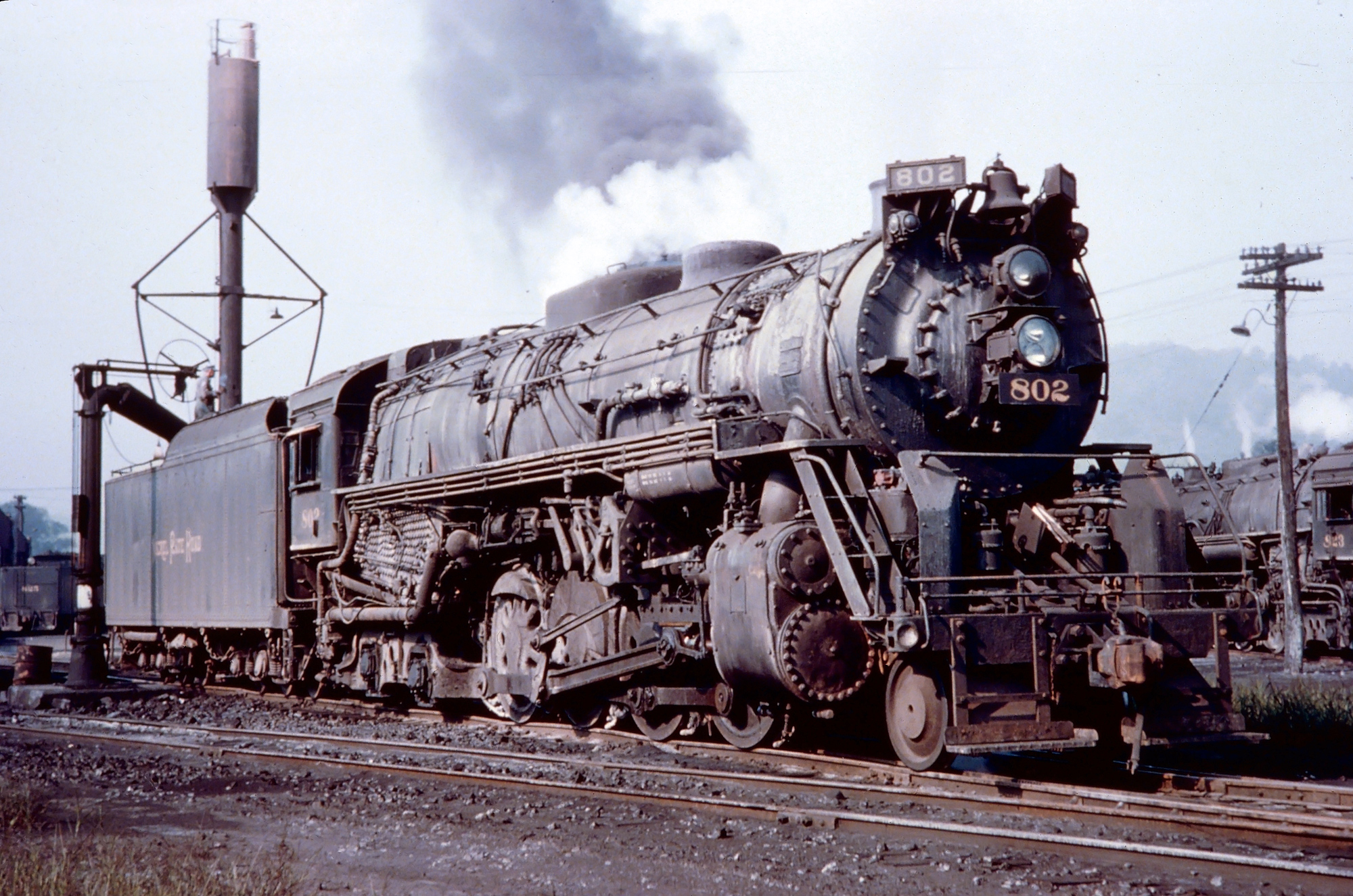 Nickel Plate Road 2-8-4 #802 was photographed here by Homer Newlon, Jr. being serviced at the former Wheeling & Lake Erie engine terminal in Dilonvale, Ohio on September 5, 1955. American-Rails.com collection.
Nickel Plate Road 2-8-4 #802 was photographed here by Homer Newlon, Jr. being serviced at the former Wheeling & Lake Erie engine terminal in Dilonvale, Ohio on September 5, 1955. American-Rails.com collection.Development
The Berkshire, a remarkable innovation in steam power, was conceived by the Lima Locomotive Works. At the time, Lima was a respected yet comparatively modest manufacturer, eager to enhance the capabilities of the existing USRA Mikado design (2-8-2).
The Mikado, while dependable and adept within its range, fell short in terms of speed and horsepower, particularly under the demands of heavy haulage across challenging mountainous terrains.
In response to these limitations, Lima Locomotive Works embarked on a quest to create a locomotive that would not only overcome these challenges but also redefine efficiency and power in steam locomotive engineering. The result was the Berkshire—a locomotive that would leave a lasting legacy in the annals of railroad history.
In 1924, a significant innovation in locomotive design was conceived by William Woodward, the engineering vice president at Lima Locomotive Works.
Woodward embarked on an ambitious project to enhance the performance of the existing 2-8-2 configuration. His landmark experiment began with a deep analysis of the New York Central Class H-7e Mikado #8000, built by Lima in 1922.
Woodward hypothesized that integrating a larger firebox could substantially increase the locomotive's power. His pioneering modifications led to the creation of a more robust, 100 square-foot firebox.
This enhancement not only boosted the engine's capabilities but also necessitated an additional trailing axle to support the increased size and weight. This modification changed the locomotive's configuration to a 2-8-4 wheel arrangement, marking the birth of a new class briefly referred to as H-10.
This visionary engineering feat by Woodward not only redefined the potential of steam locomotives but also set a benchmark in locomotive design that would influence future generations.
The new steamer was designated Class A-1 and not only included an upgrade firebox but also other features to improve horsepower including a larger boiler, sufficient air-intake, booster, and limited cutoff.
The 2-8-4 (listed as #1) was then sent for testing along the stiff grades of the Boston & Albany in the Berkshire Mountains of northwestern Massachusetts in the spring of 1925.
After very successful tests against a Class H-10 Mikado on April 14th where the Class A-1 easily outperformed the 2-8-2.
- The 2-8-4 left Selkirk Yard nearly 50 minutes after the Class H-10 and pulling a train that was over 600 tons heavier, yet arrived at North Adams Junction ten minutes ahead of the Mikado! -
The B&A quickly ordered 45 Berkshire locomotives. In all, the B&A would roster a fleet of 55 2-8-4s, Class A1a/b #1400-1444 and Class A1c #1445-1454.
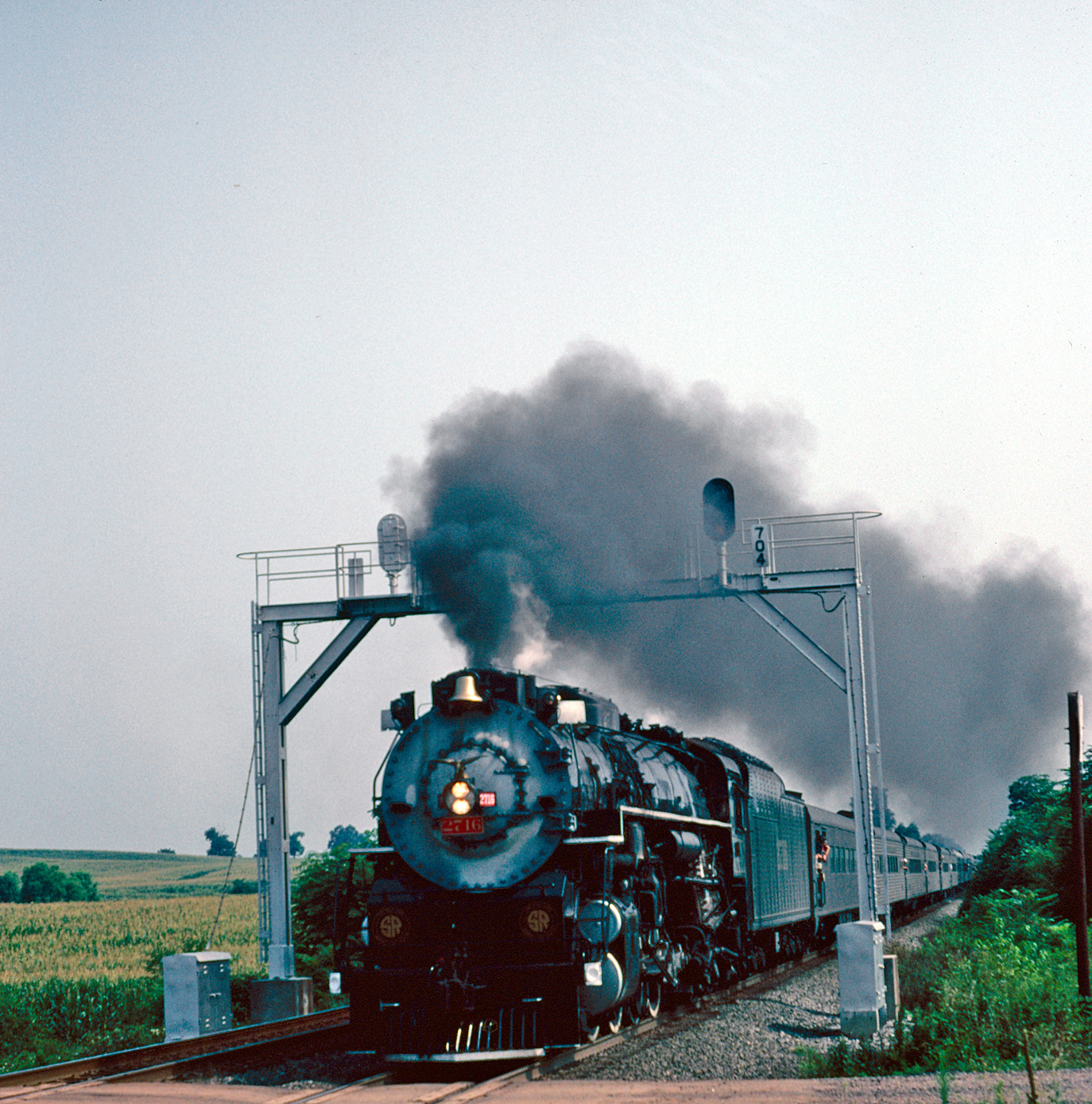 Chesapeake & Ohio 2-8-4 #2716 (K-4), dressed in Southern Railway colors, leads an excursion southbound just south of Culpeper, Virginia along Highway 522 on a July morning in 1982. The locomotive spent a few years in Southern's steam program at this time. American-Rails.com collection.
Chesapeake & Ohio 2-8-4 #2716 (K-4), dressed in Southern Railway colors, leads an excursion southbound just south of Culpeper, Virginia along Highway 522 on a July morning in 1982. The locomotive spent a few years in Southern's steam program at this time. American-Rails.com collection.Following the successful trials, the 2-8-4 locomotive was aptly named after the mountainous regions where it first proved its mettle. Interestingly, the prototype was not purchased by the Boston & Albany as one might expect.
Instead, Lima saw a greater opportunity to showcase the locomotive's capabilities on a broader scale. They utilized the robust steamer as a demonstration unit, sending it across the country to various railroads for testing.
This strategic move garnered significant attention and accolades from several railroads, notably the Illinois Central. Impressed by the 2-8-4's performance, Illinois Central didn't just stop at testing; they purchased the demonstrator unit, which they renumbered as #7049.
Bolstered by the initial tests, IC became an enthusiastic buyer, acquiring a total of 50 Berkshires in 1926, merely a year after the locomotive’s debut tests on the Boston & Albany track. This move marked a significant endorsement of Lima's innovative design and showcased the locomotive’s suitability for diverse service.
The 2-8-4 locomotives not only heralded a novel design but also garnered a laudatory classification - Class A-1 - on the Illinois Central, where they remained operational through the mid-1950s.
Their reliability and efficiency led to adoption by an impressive array of nineteen different railroads, with the Erie Railroad holding the record for the most units owned, boasting a fleet of 105.
In total, more than 600 of these formidable locomotives were constructed by the industry's three major manufacturers: Alco, Lima, and Baldwin. Among these, the Chesapeake & Ohio's fleet of 90 deserves special mention.
These locomotives were aptly renamed Kanawhas (after the Kanawha River, tracing through southern West Virginia where part of the railroad's main line was situated) and classified as Class K-4. Each detail of their operation and service reflects a rich chapter in the annals of American railroading.
The C&O's fleet also included a set of 39 acquired from the Pere Marquette after assuming control of this Michigan line. Chessie's decision to embrace the 2-8-4 came after a careful evaluation of their operational success on the Pere Marquette and Nickel Plate lines.
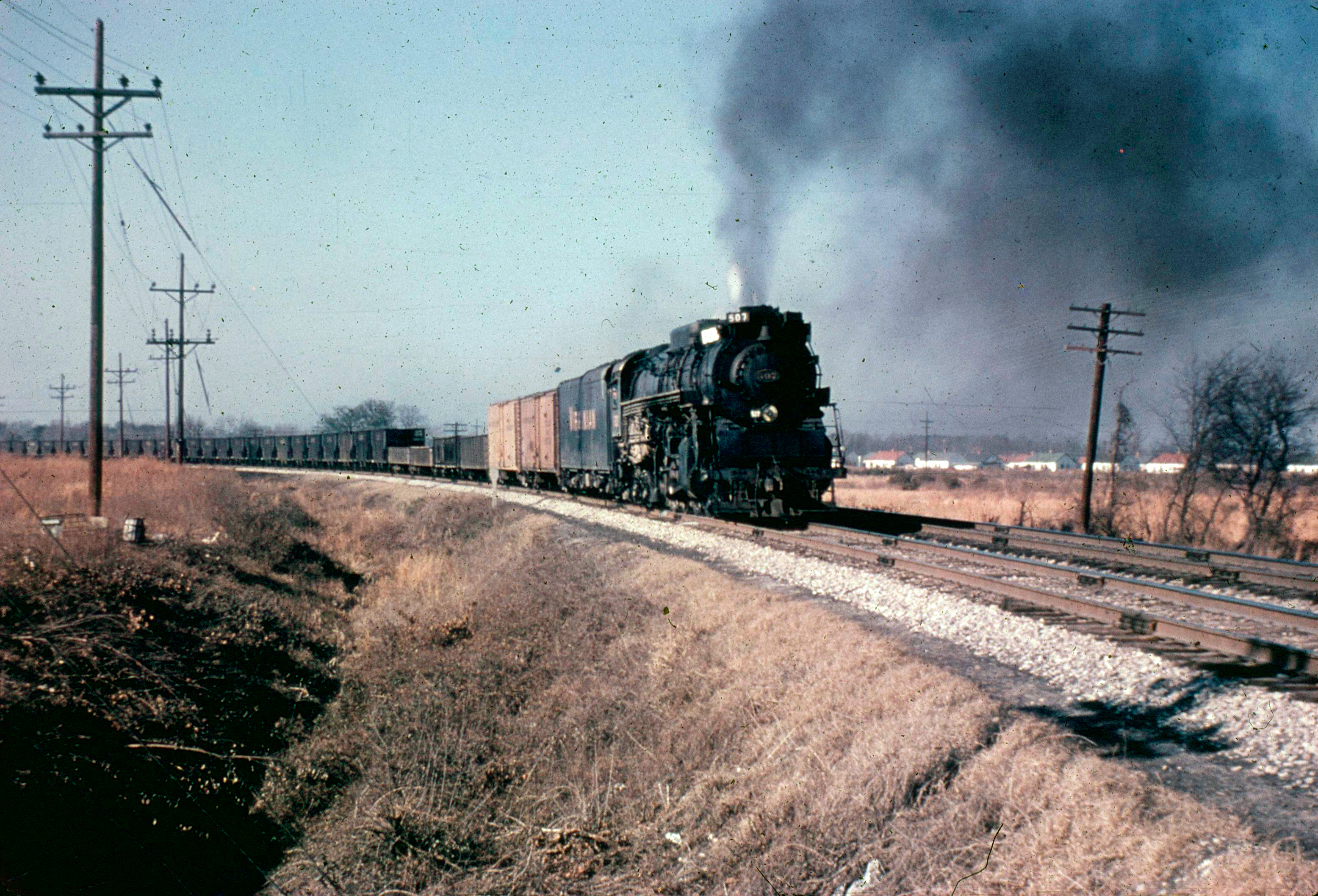 Virginian Railway 2-8-4 #507 (Class BA) rolls through Simpson's Curve in Norfolk, Virginia during the spring of 1954. Author's collection.
Virginian Railway 2-8-4 #507 (Class BA) rolls through Simpson's Curve in Norfolk, Virginia during the spring of 1954. Author's collection.The C&O's Kanawhas emerged as some of the heaviest and longest examples within the 2-8-4 classifications, boasting tractive efforts of nearly 70,000 pounds. This strategic acquisition underscored Chesapeake & Ohio's commitment to leveraging advanced steam technology to enhance its freight services.
The preservation of the 2-8-4 owes much to the foresight and generosity of the C&O. Demonstrating a commitment to heritage and community, the railroad donated 13 of these magnificent machines to various municipalities across its network. This gracious act ensured that future generations would have the opportunity to witness and appreciate the splendor of these historical marvels.
In the pantheon of 2-8-4s, the versions operated by Nickel Plate are often celebrated as particularly striking examples of the design. Highlighted below are some general specifications of Nickel Plate's famed Berkshires, regarded by many as the most aesthetically pleasing among all the 2-8-4s ever constructed.
Specifications (Nickel Plate Road)
Builder – Lima, Baldwin, and Alco (NKP Berkshires were built by Lima)
Fuel - 22 tons
Cylinders (2) - 25" x 34"
Water - 22,000 Gallons
Weight – 802,500 Pounds
Diameter of Drivers – 69 Inches
Steam Pressure - 245 PSI
Tractive Effort – 64,100 Pounds
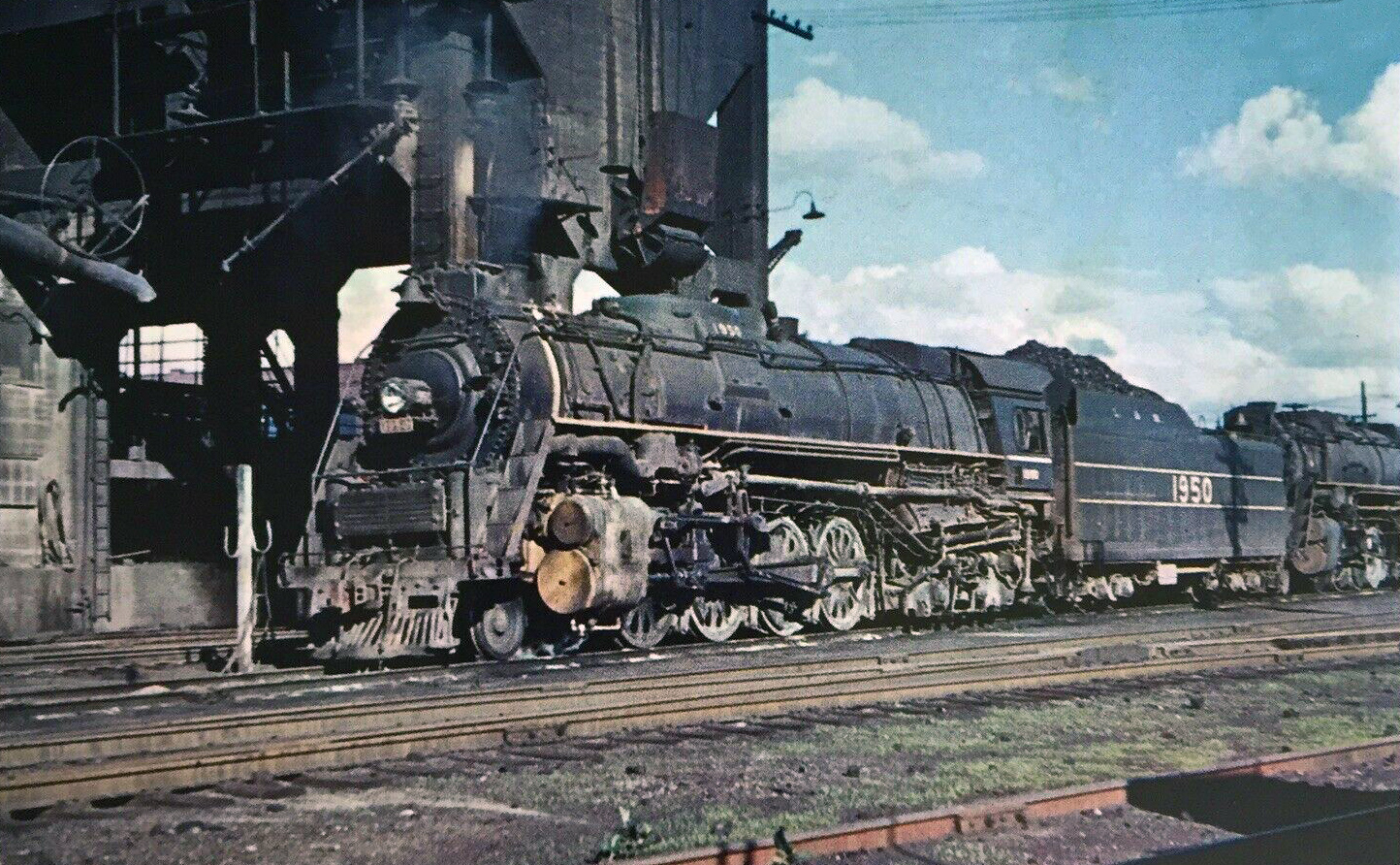 Louisville & Nashville 2-8-4 "Big Emma" #1950 awaits its next assignment at the coaling tower in Corbin, Kentucky following refueling on May 25, 1952. Bob Collins photo.
Louisville & Nashville 2-8-4 "Big Emma" #1950 awaits its next assignment at the coaling tower in Corbin, Kentucky following refueling on May 25, 1952. Bob Collins photo.For Lima which was still emerging as a competitor in the locomotive manufacturing industry, the development of the 2-8-4 locomotive was a game-changing achievement. This innovative design catapulted the builder into the major leagues, positioning it alongside established giants like Baldwin and Alco in the realm of main line steam locomotives.
Despite consistently ranking third behind these industry behemoths, Lima was often celebrated as one of the "Big Three" in locomotive manufacturing, earning widespread acclaim for the high quality and exceptional craftsmanship of its designs.
However, the era of the Berkshire, as groundbreaking as it was, proved relatively brief. Though the 2-8-4 continued to be produced into the early 1940s, its dominance was fleeting, marking a poignant chapter in the history of steam locomotion.
Just a few years after the successful debut of the 2-8-4, Alco marked another milestone in railway history with the introduction of the 4-8-4 wheel arrangement, unveiled during tests along the Northern Pacific in January 1927.
This innovative design, which soon earned the moniker "Northern," quickly eclipsed the Berkshire as the preeminent mainline steam locomotive of the era.
The Northern represented the pinnacle of steam locomotive development and, in many regards, stood as the final flourish of steam power before the diesel age dawned in the subsequent decade. This transition marked a significant turning point in the evolution of railway technology.
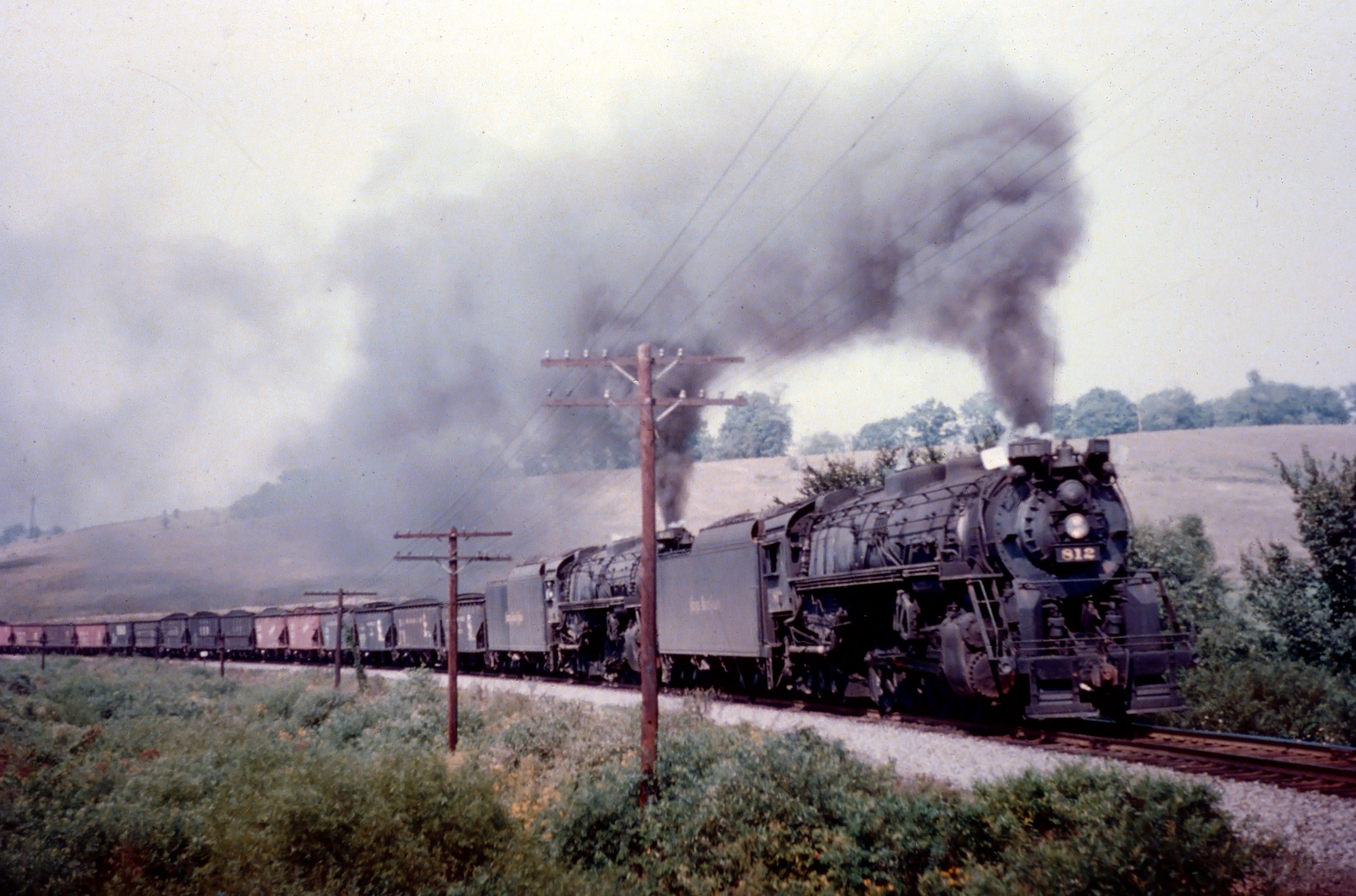 A pair of Nickel Plate Road 2-8-4s, led by #812, lead a heavy coal drag over the former Wheeling & Lake Erie near Scio, Ohio on September 5, 1955. Homer Newlon, Jr. photo. American-Rails.com collection.
A pair of Nickel Plate Road 2-8-4s, led by #812, lead a heavy coal drag over the former Wheeling & Lake Erie near Scio, Ohio on September 5, 1955. Homer Newlon, Jr. photo. American-Rails.com collection.Preserved Examples
Today, impressively two of these large steamers still operate; Nickel Plate Road Class S2 #765 and Pere Marquette Class N-1 #1225 (who has become quite famous as the Polar Express).
There are also two others that are currently in a state of restoration including:
- C&O #2789 owned by the Hoosier Valley Railroad Museum of North Judson, Indiana (cosmetic only).
- C&O #2716, owned by the Kentucky Railway Museum and under restoration at the Kentucky Steam Heritage Corporation.
Along with these operational Berkshire locomotives another of Pere Marquette’s survive and four other of the Nickel Plate’s. Additionally twelve of the C&O’s Kanawhas also survive.
| Engine Number | Class | Wheel Arrangement | Track Gauge | Original Owner | Current Location | Current Status | Builder Information | Notes |
|---|---|---|---|---|---|---|---|---|
| 2705 | K-4 | 2-8-4 | 4' 8 ½" | Chesapeake & Ohio | B&O Railroad Museum (Baltimore) | Display | Alco-Schenectady #70854 (1943) | Originally displayed at Russell, Kentucky. |
| 757 | S2 | 2-8-4 | 4' 8 ½" | New York, Chicago & St. Louis | Mad River & NKP Railroad Museum (Bellevue, Ohio) | Display | Lima #8665 (1944) | From the Railroad Museum of Pennsylvania (Strasburg). |
| 755 | S2 | 2-8-4 | 4' 8 ½" | New York, Chicago & St. Louis | Conneaut Station (Conneaut, Ohio) | Display | Lima #8663 (1944) | - |
| 2700 | K-4 | 2-8-4 | 4' 8 ½" | Chesapeake & Ohio | Dennison Railroad Depot Museum (Dennison, Ohio) | Display | Alco-Schenectady #70849 (1943) | - |
| 1223 | N-1 | 2-8-4 | 4' 8 ½" | Pere Marquette Railway | North Harbor Drive (Grand Haven, Michigan) | Display | Lima #7837 (1941) | - |
| 2736 | K-4 | 2-8-4 | 4' 8 ½" | Chesapeake & Ohio | National Railroad Museum (Green Bay) | Display | Alco-Schenectady #70885 (8/1944) | - |
| 779 | S3 | 2-8-4 | 4' 8 ½" | New York, Chicago & St. Louis | Lincoln Park (Lima, Ohio) | Display | Lima #9380 (1949) | Last steam locomotive built by Lima. |
| 2755 | K-4 | 2-8-4 | 4' 8 ½" | Chesapeake & Ohio | Chief Logan State Park (Logan, West Virginia) | Display | Lima #9262 (1947) | On National Register of Historical Places. |
| 2760 | K-4 | 2-8-4 | 4' 8 ½" | Chesapeake & Ohio | Treasure Island Road (Lynchburg, Virginia) | Display | Alco-Schenectady #75173 (1947) | - |
| 765 | S2 | 2-8-4 | 4' 8 ½" | New York, Chicago & St. Louis | Fort Wayne Railroad Historical Society (New Haven, Indiana) | Operational | Lima #8673 (1944) | - |
| 2756 | K-4 | 2-8-4 | 4' 8 ½" | Chesapeake & Ohio | Huntington Park (Newport News, Virginia) | Display | Lima #9263 (1947) | - |
| 2789 | K-4 | 2-8-4 | 4' 8 ½" | Chesapeake & Ohio | Hoosier Valley Railroad Museum (North Judson, Indiana) | Display | Alco-Schenectady #75202 (1947) | - |
| 1225 | N-1 | 2-8-4 | 4' 8 ½" | Pere Marquette Railway | Steam Railroading Institute (Owosso, Michigan) | Operational | Lima #7839 (1941) | - |
| 2716 | K-4 | 2-8-4 | 4' 8 ½" | Chesapeake & Ohio | Kentucky Steam Heritage Corporation (Ravenna, Kentucky) | Restoration | Alco-Schenectady #70865 (1943) | Owned by the Kentucky Railway Museum. Will burn oil once operational. |
| 2732 | K-4 | 2-8-4 | 4' 8 ½" | Chesapeake & Ohio | Science Museum of Virginia (Richmond, Virginia) | Display | Alco-Schenectady #70881 (1944) | - |
| 759 | S2 | 2-8-4 | 4' 8 ½" | New York, Chicago & St. Louis | Steamtown National Historic Site (Scranton, Pennsylvania) | Display | Lima #8667 (1944) | Operated excursions in the 1960s and 1970s. Retired in 1977. |
| 2727 | K-4 | 2-8-4 | 4' 8 ½" | Chesapeake & Ohio | Museum of Transportation (St. Louis) | Display | Alco-Schenectady #70876 (1944) | - |
| 763 | S-22 | 2-8-4 | 4' 8 ½" | New York, Chicago & St. Louis | Age of Steam Roundhouse (Sugarcreek, Ohio) | Display | Lima #8671 (1944) | - |
| 2707 | K-4 | 2-8-4 | 4' 8 ½" | Chesapeake & Ohio | Illinois Railway Museum (Union) | Display | Alco-Schenectady #70856 (1943) | - |
| 2776 | K-4 | 2-8-4 | 4' 8 ½" | Chesapeake & Ohio | Jesse Eyman Park (Washington Court House, Ohio) | Display | Alco-Schenectady #75189 (1947) | - |
Recent Articles
-
Illinois Thomas The Train Rides
Dec 21, 25 12:30 PM
In Illinois, the "A Day Out With Thomas" event offers a unique chance for families to immerse themselves in the enchanting world of Thomas and friends, creating memories that last a lifetime. -
Texas - Wine Tasting - Train Rides
Dec 21, 25 11:05 AM
This article invites you on a metaphorical journey through some of these unique wine tasting train experiences in Texas. -
New York - Wine Tasting - Train Rides
Dec 21, 25 10:58 AM
This article will delve into the history, offerings, and appeal of wine tasting trains in New York, guiding you through a unique experience that combines the romance of the rails with the sophisticati…



